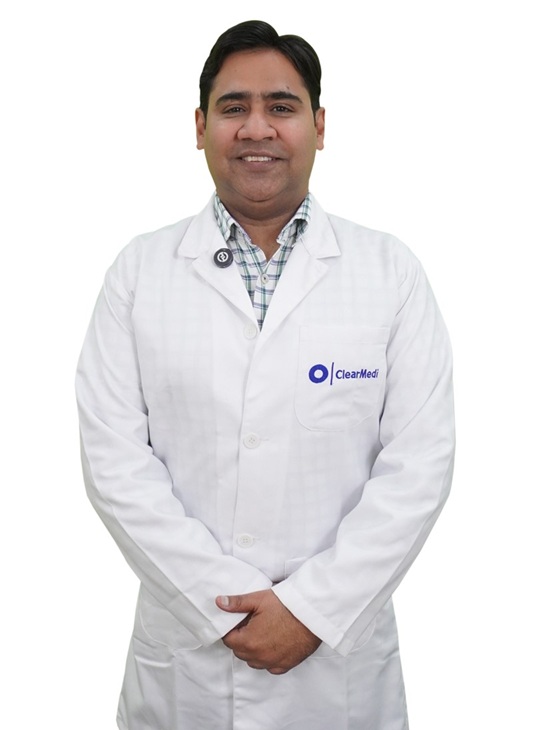The PAC Test: Full Form, Purpose, Benefits, and Report Insights

Quick Summary
- The PAC test is a pre-anaesthesia check-up that is done before surgery. It helps to assess the patient's overall health and ensure that they are fit for surgery.
- The PAC test includes a medical history assessment, physical examination, laboratory tests, and imaging studies.
- The results of the PAC test help the surgeon and anesthesiologist to plan for surgery and ensure that the patient has a smooth and safe experience.
When you have to go to the hospital, it can make you nervous, especially when the doctor suggests surgery. If your surgeon recommends surgery, they'll ask you to do a PAC test.
The PAC test full form is a pre-anaesthesia check-up or PAC test. Several people question what the PAC test means. Hence, in this blog, we will look into the purpose, benefits, and significance of the PAC test report.
Alternative Name | Pre-Anaesthetic Checkup (PAC test) |
Prerequisites |
|
Test Done By | An anaesthesiologist |
Parameters | 1. Medical History Assessment 2. Physical Examination:
3. Laboratory Tests:
4. Imaging Studies:
|
Report Time | Within 24 hours |
What is the PAC Test?
Before any surgery, evaluating if the patient can handle it is crucial. This evaluation, known as a pre-anaesthesia check (PAC), involves the surgeon and anaesthesiologist.
PAC happens before giving anaesthesia, aiming to identify existing health issues and uncover new ones that could impact patient care during and after surgery. This proactive approach helps plan and adjust inpatient care for a safer surgery.
A PAC involves getting the patient's history, conducting a physical examination, and reviewing relevant medical records if available. A well-executed PAC lowers the risks during and after surgery. It can lead to additional benefits, such as shorter hospital stays.


Need for PAC Test
The primary goal of the PAC test is to assess the patient's overall health. It identifies pre-existing medical issues like bleeding disorders and allergies that may interfere with the surgical procedure. The assessment assists in adapting the anesthetic plan to the patient's specific needs.
PAC test can be exempted for minor procedures like biopsy incision, drainage of lesion of skin, breast abscess drainage, cataract surgery, etc. In these cases, a general examination is done. It includes checking the weight and monitoring vitals SPO2, pulse rate, blood pressure, temperature, and respiratory rate.
More comprehensive testing becomes essential for complex procedures or when dealing with patients with moderate to severe systemic diseases or those at substantial risk of mortality. These include laparoscopic or open hernia surgeries, cardiac surgery, neurosurgery, radical cancer surgeries of the head and neck, etc. However, the PAC test is mandated for patients above 50 years.
General anesthesia procedures warrant thorough pre-anesthetic evaluation regardless of the procedure's complexity.
Benefits of PAC Test
The PAC test is a crucial prelude to surgery, offering a proactive and personalised approach to patient care. The key advantages are listed below:
Improved Patient Safety: The PAC test guarantees the patient's safety during anaesthesia administration. It considers numerous health parameters and potential risks particular to the individual.
Customised Anaesthetic Plan: The test enables the anaesthesiologist to adjust the anaesthesia strategy to the patient's specific health needs. It results in a more personalised and successful approach.
Identifying Risks: Early diagnosis of pre-existing medical disorders or risk factors (hypertension or asthma) that may compromise anaesthesia administration or operation itself.
Optimal Patient Preparation: Doctors can address probable difficulties in advance by reviewing the patient's medical history, physical condition, and laboratory findings. It improves the patient's overall preparation for surgery.
Minimisation of Complications: Potential concerns, such as allergies or underlying health conditions, can be identified and managed. It can reduce the risk of complications before and after surgery.
Improved Surgical Results: It contributes to better surgical outcomes by proactively addressing health concerns and reducing the chance of anaesthesia-related complications like allergic reactions or nausea.
Preparation of PAC Test
Before surgery, it's essential to follow the guidelines provided by the doctors to ensure a safe and successful procedure. These instructions cover dietary restrictions, personal hygiene, and lifestyle habits.
Eating and Drinking: Prior to undergoing any form of anaesthesia, fasting is required. It is required to have an empty stomach for six to eight hours without solids and abstain from water intake for at least two hours.
Babies can have breast milk up to four hours before surgery. Follow specific diet instructions for endoscopy, colonoscopy, and certain intestinal surgeries.Bath and Shave: Shower the night before and on the day of surgery. Avoid shaving the operation area; medical staff will handle it if necessary. Scrub fingernails with a brush and trim facial hair to ensure proper oxygen mask fitting.
Smoking: It is strongly encouraged to quit smoking and tobacco use before surgery. It reduces the risk of respiratory and cardiac complications, promoting a faster recovery.
Blood Thinners: Inform the anaesthetist about any blood-thinning medications. Medication adjustments may be necessary before the surgery. Blood thinners like aspirin may be advised to discontinue 48 hours before the surgery.
Nail Polish: Remove nail polish before surgery. It allows accurate monitoring of oxygen levels during the procedure.
Dentures: Patients who wear dentures should remove them before surgery.
PAC Test Procedure
An appointment is scheduled with the anaesthesiologist for a pre-anaesthetic checkup. The procedure follows:
The doctor will assess your overall health and medical history during the checkup.
To evaluate your fitness, the doctor will check for symptoms like a cold, cough, or upper respiratory issues.
Your blood pressure, hypertension, and diabetes (if applicable) will be examined.
The thyroid will be checked for conditions like hypothyroidism or hyperthyroidism.
Special attention will be given to the health of your heart, especially if you've had surgeries like angioplasty. Tests will be conducted to ensure there are no other heart complications.
Laboratory tests will be recommended, including creatine, haemoglobin, kidney, and liver tests.
You'll be referred to a specialised doctor if any specific medical conditions require attention.
A personalised plan will be created based on the evaluation and your medical needs.
The primary goal of the pre-anaesthetic checkup is to ensure your safety and comfort during surgery. The plan will be discussed with you, and surgery will be scheduled. Postoperative requirements will also be explained.
Before the surgery, you will receive information about the potential risks and be asked to sign a consent form.
Aftercare of PAC Test
The significance of post-PAC care lies in ensuring that one remains optimally prepared for the impending surgical or medical procedure. While the aftercare may vary based on the specific tests performed and your health condition, the basic guidelines to consider are:
Resumption of Normal Activities: In most circumstances, you can resume your daily activities immediately following the PAC test. However, if anaesthesia or certain tests were administered, your doctor may urge you to rest for a while. Follow any activity limits that have been provided.
Keep Hydrated: Unless your doctor has given you special advice regarding fasting or food restrictions, drink plenty of fluids.
Consume Regular Meals: Return to your regular eating schedule unless advised otherwise. If asked to fast for some exams, you may be encouraged to eat a light meal after the tests.
Monitor for Any Unusual Symptoms: Look for odd symptoms or adverse effects like allergic reactions following the PAC test. Contact your doctor immediately if you are experiencing chronic discomfort, pain, or other troubling symptoms.
Examine the Test Results: Your doctor will discuss the PAC test results with you whenever available. Take your time learning about the findings. Ask any questions you may have regarding your health or the scheduled procedure.
Results of PAC Test
The results of a PAC test provide a comprehensive assessment of a patient's health. The report includes details on the patient's medical history, physical examination findings, laboratory test results, and electrocardiogram analysis.
Normal findings indicate that the patient is generally fit for the planned surgery. However, abnormal results may require further investigation or specific considerations in the anaesthesia plan.
It's essential to get the PAC test results reviewed with your doctor. They will explain the findings and discuss the implications for your upcoming surgery. Collaborative communication between you and your doctor is important to ensure a smooth and safe surgical experience.
Treatment Plan After PAC Test
The treatment plan developed after a pre-anaesthetic test is critical in providing personalised and safe anaesthesia care. This plan considers individual health factors and is essential for a successful surgical outcome.
Adjustments to pre-existing medications are made to minimise potential complications during the surgery.
During the surgery, the patient is monitored through the following components:
Vitals: A monitor tracks vital signs such as heart rate, blood pressure, and oxygen levels throughout the procedure. It ensures immediate detection of any deviations.
Fluid Management: Intravenous fluids are administered as needed to maintain proper hydration levels during surgery, contributing to overall physiological stability.
Emergency Preparedness: Contingency plans are implemented to address any unforeseen complications, with the anaesthesia team well-prepared to manage emergencies promptly and effectively.
Risks of PAC Test
While the PAC in medical is important in ensuring patient safety, it comes with potential risks. It's important to note that these risks are generally minimal compared to the benefits of thorough preoperative assessment. The potential risks associated with the PAC test are:
Discomfort: Physical examinations, blood samples, and other imaging procedures may cause momentary discomfort. Healthcare specialists, however, strive to minimise any discomfort during the procedure.
Bruising and Bleeding: Minor bleeding or bruising at the needle insertion site may occur during blood sample collection for laboratory tests. It is normally temporary and goes away on its own.
False Positives or Negatives: Test findings may occasionally provide false positives (showing an issue that does not exist) or false negatives (missing an existing problem).
Cost of PAC Test
The cost of a PAC test can vary based on several factors. Understanding these factors can help individuals anticipate the potential costs associated with preanaesthetic testing.
Patients should discuss the details and related expenses with their healthcare providers and insurance companies to better understand the financial aspects involved.
Below are the factors that influence the cost of the PAC test:
Location: The cost may vary depending on the geographical location and the specific healthcare facility where the test is conducted. The price of the PAC test can differ between urban and rural areas.
Healthcare Facility: Different hospitals or clinics may have different pricing structures. Multispeciality hospitals may charge higher fees compared to smaller diagnostic centres.
Type of Anaesthesia: The type of anaesthesia planned for the procedure can influence the cost. Complex procedures requiring general anaesthesia techniques may need additional testing, affecting the overall expense.
Additional Consultations: If additional consultations with specialists are required, such as consultations with a cardiologist or pulmonologist, this can contribute to the overall cost.
Diagnostic Tests Involved: The specific diagnostic tests included in the preanaesthetic assessment can affect the overall cost. Blood tests, ECG, and imaging studies may have varying prices.
Facility Amenities: The amenities and services offered by the healthcare facility can influence the cost. Facilities with advanced technologies and comfortable amenities may charge higher fees.
Test Name | Cost Value |
Pre-anaesthesia Check-up Test | ₹ 3,000 - ₹ 12,000 |
Takeaway
The PAC test is an important step in ensuring the safety and well-being of anaesthesia-assisted surgery patients. This detailed review enables doctors to adjust anaesthesia plans for each patient's needs.
Doctors reaffirm their commitment to protecting patients and strive for successful surgical results by taking the PAC test. Have more queries regarding what the PAC test means or other medical issues? Contact HexaHealth for top-notch guidance!
Suggested Reads
| eGFR Blood Test |
Kidney Diagnostic Tests |
| Leukaemia Diagnosis Through Blood Test |
Serum Creatinine Test |
Frequently Asked Questions
What is PAC in medical?
PAC in medical stands for Pre-Anaesthetic Checkup. It is a thorough assessment conducted before surgery to evaluate the health of the patient. It assists in identifying potential risks related to anaesthesia.
What is the PAC test full-form?
The PAC test full form is "Pre-Anaesthetic Checkup." It is a comprehensive evaluation conducted by anaesthesiologists or doctors specialised in anaesthesia. It assesses a patient's fitness for anaesthesia and surgery.
When is the PAC test recommended?
The Pre-Anaesthetic Checkup (PAC) Test is recommended before any surgical procedure requiring anaesthesia. It is typically conducted in the preoperative phase to check the patient's health and identify risks.
Why is pre-anaesthetic assessment important?
The pre-anaesthetic assessment is important to evaluate a patient's health and identify potential risks. It allows doctors to customise the anaesthesia plan and minimises the likelihood of complications during surgery, like allergic reactions.
What are the benefits of undergoing the PAC test?
The benefits of undergoing the PAC test are:
Early detection of underlying medical conditions
Customised anaesthesia plan
Minimisation of complications
Enhanced patient safety
Improved surgical outcomes
What are the rules before anaesthesia?
The rules before anaesthesia are:
Fasting from food (8 to 6 hours) and clear liquids (2 hours) before the procedure.
Showing all the medications, including over-the-counter drugs and supplements.
Informing doctors about any allergies to medications or substances.
Providing a detailed medical history, including past surgeries and chronic conditions.
What happens in pre-anaesthesia testing?
The pre-anaesthesia testing includes:
Medical history assessment
Physical examination
Laboratory tests
Imaging studies (e.g., X-rays)
What information does the PAC test report typically include?
The PAC test report typically includes:
Medical history summary
Physical examination findings
Laboratory test results
Electrocardiogram (ECG) analysis
Imaging study findings
Specialised test results
Anaesthesia plan recommendations
What is the importance of PAC test results for individuals?
The PAC test results are crucial for individuals as they provide a comprehensive health assessment and ensure personalised care during surgery. The findings help identify potential risks and allow for proactive measures.
Are there specific conditions or situations where the PAC test is not recommended?
The specific conditions or situations where the PAC test may not be recommended are:
Severe medical emergencies like cardiac arrest
Patients unable to provide informed consent
Presence of contraindications to anaesthesia (uncontrolled sepsis, severe cardiac failure)
How does the PAC test contribute to medical diagnosis and treatment?
The PAC test contributes to medical diagnosis and treatment in certain ways:
Identifies pre-existing medical conditions
Evaluates the patient's fitness for anaesthesia and surgery
Guides customisation of anaesthesia plan based on individual health
Detects potential complications and minimises risks
Optimises surgical outcomes
What role does the PAC test play in assessing cardiovascular health?
The PAC test evaluates cardiovascular function through blood pressure and heart rate parameters. It assesses the heart's electrical activity with an electrocardiogram (ECG).
Who conducts the PAC test?
An anaesthesiologist or a doctor specialising in anaesthesia typically conducts the PAC test. They receive training to perform physical examinations and interpret test results.
Can you discuss the process of undergoing a PAC test?
The process of undergoing a PAC test is as follows:
Detailed medical history assessment
Thorough physical examination, including vital signs (heart rate, blood pressure)
Blood tests for various parameters (complete blood count, liver function test)
Electrocardiogram (ECG) for heart evaluation
Imaging studies, such as chest X-rays
Discussion of findings
What is the average duration of a PAC test?
The average duration of a Pre-Anaesthetic Checkup (PAC) Test is typically around 1 to 2 hours. However, it may vary based on the complexity of the evaluation and the specific tests conducted.
Are there any specific timelines for getting a PAC test before surgery?
Before surgery, the timing for a Pre-Anaesthetic Checkup (PAC) Test can vary. However, it is typically conducted a few days to weeks before the scheduled surgery. The exact timeline depends on the complexity of the procedure.
What are the tests included in PAC?
The tests included in PAC are:
Medical history assessment
Physical examination
Laboratory tests
Electrocardiogram (ECG)
Imaging studies (e.g., chest X-ray)
Specialised tests based on the patient's age or medical condition
What may happen if PAC test reports are abnormal?
If the PAC test shows something unusual, your doctors will investigate further to understand the issue. They will adjust your care plan, ensuring your safety and making any necessary changes before the surgery.
References
All the articles on HexaHealth are supported by verified medically-recognized sources such as; peer-reviewed academic research papers, research institutions, and medical journals. Our medical reviewers also check references of the articles to prioritize accuracy and relevance. Refer to our detailed editorial policy for more information.
- Reazaul Karim H, Prakash A, Sahoo S, Narayan A, Vijayan V. Abnormal routine pre-operative test results and their impact on anaesthetic management: An observational study. Indian Journal of Anaesthesia. 2018;62(1):23.

- Dhakre VW, Nanavati AJ, Shakil M, Nagral SS. Pre-anaesthetic checkup In India: A review. Surgery in Practice and Science. 2020 Jun;1:100005.

- Tiwari DrS. Importance of Pre-anesthesia Checkup/PAC Test Before Surgery. 2020 Nov 8 [cited 2023 Nov 18];

- Procedures/Risks: blood draws, IV lines, vitals_template [Internet].

- Thampi S, James J. Time spent by patients in a pre-anaesthetic clinic and the factors affecting it: An audit from a tertiary care teaching hospital. Indian Journal of Anaesthesia. 2018;62(1):16.

- How to Understand Your Lab Results: MedlinePlus Lab Test Information [Internet]. medlineplus.gov. 2023.

- Get Screened - MyHealthfinder | health.gov [Internet]. health.gov. [cited 2023 Nov 18].

Last Updated on: 14 August 2024
Reviewer

Dr. Aman Priya Khanna
MBBS, DNB General Surgery, Fellowship in Minimal Access Surgery, FIAGES
14 Years Experience
Dr Aman Priya Khanna is a well-known General Surgeon, Proctologist and Bariatric Surgeon currently associated with HealthFort Clinic, Health First Multispecialty Clinic in Delhi. He has 14 years of experience in General Surgery, Proctolo...View More
Author

She has extensive experience in content and regulatory writing with reputed organisations like Sun Pharmaceuticals and Innodata. Skilled in SEO and passionate about creating informative and engaging medical conten...View More
Expert Doctors (10)
NABH Accredited Hospitals (5)
Latest Health Articles
Related Treatments



























 Open In App
Open In App